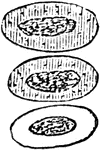Clipart tagged: ‘"frog's blood"’

Effect of Acetic Acid on Red Blood Cells
Acetic acid (dilute) causes the nucleus of the red blood cells in the frog to become more clearly defined;…

Effect of Boric Acid on Red Blood Cells
A 2 percent solution of boric acid applied to nucleated red blood cells of a frog will cause the concentration…

Effect of Gases on Red Blood Cells
If the red blood cells of a frog be first exposed to the action of water vapor (which renders their…

Effect of Tannin on Red Blood Cells
When a 2 percent fresh solution of tannic acid is applied to frog's blood it causes the appearance of…